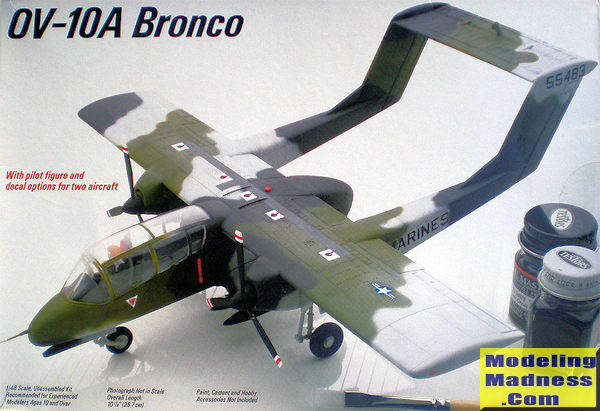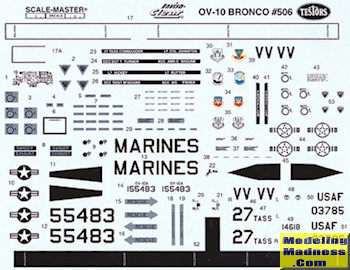
| KIT #: | 506 |
| PRICE: | I paid $11 for it still in shrink wrap |
| DECALS: | Two options |
| REVIEWER: | Scott Van Aken |
| NOTES: | Ex-Hawk kit |

| HISTORY |
In the early '60s, there was a requirement from all US Armed Services for a Light Attack and Reconnaissance Aircraft (LARA). The aircraft should also be able to perform the function as a COIN (COunter INsurgency) aircraft as well. This meant that it needed to be able to carry a variety of ordnace in addition to having internal guns. It should also be easy to maintain and equally easy to fly. North American's entry into the field was what was eventually to become the OV-10 'Bronco'.
It is powered by two small turboprops, has four 20mm cannon in a short weapons pod and is also capable of handling various ordnance including 2.75 and 5 inch rocket pods, 1,000 bombs, marker rockets and Sidewinder missiles for self defense. There is an aft cargo area that can handle two stretchers or five fully equipped troops.
The OV-10 was first introduced in the last few years of the Vietnam War as a replacement FAC (Forward Air Controller) to replace the Cessna O-2A. It was an instant success as it was armed, better protected and faster than the O-2. It was also used by several Marine Corps Squadrons and by one (perhaps two) Navy squadrons as well. After the end of the war, the OV-10 was still in use by regular USAF squadrons in both the US and overseas. It is one of the few aircraft that was not used by the USAF Air National Guard, those units getting the OA-37B instead. The final USAF OV-10 was retired in the late 1980s with the last USMC versions being retired in the early 1990s. Some are still flying with air forces in central and south America. Recently a trial was made using ex-USMC OV-10Ds to see how they compared cost-wise and in terms of effectiveness against F-16s in Iraq. The OV-10s were just as if not more effective in most instances and cost a tenth to operate.
| THE KIT |
 This is a kit of the 1960s and in many ways is typical of the type. It started out in a Hawk box and here is a brief history of the company: Hawk Model Airplanes was established in 1928 by brothers Dick (Sr.) and Phil Mates, in Chicago, Illinois. Promoted as "America's Oldest Model Company", the company was purchased by the Testors Corporation in 1970. The Hawk Company assets were later acquired by J. Lloyd International, Inc. of Cedar Rapids, Iowa, which, in turn, sold them to Round2 LLC of South Bend, Indiana in 2013.
This is a kit of the 1960s and in many ways is typical of the type. It started out in a Hawk box and here is a brief history of the company: Hawk Model Airplanes was established in 1928 by brothers Dick (Sr.) and Phil Mates, in Chicago, Illinois. Promoted as "America's Oldest Model Company", the company was purchased by the Testors Corporation in 1970. The Hawk Company assets were later acquired by J. Lloyd International, Inc. of Cedar Rapids, Iowa, which, in turn, sold them to Round2 LLC of South Bend, Indiana in 2013. are four generic slick bombs. Exhaust are triangular pieces that fit on the boom sides. These have sink areas that will need filled.
are four generic slick bombs. Exhaust are triangular pieces that fit on the boom sides. These have sink areas that will need filled. | CONCLUSIONS |
| REFERENCES |
http://en.wikipedia.org/wiki/North_American_Rockwell_OV-10_Bronco
September 2016
Copyright ModelingMadness.com. All rights reserved.
If you would like your product reviewed fairly and fairly quickly, please contactthe editor or see other details in the